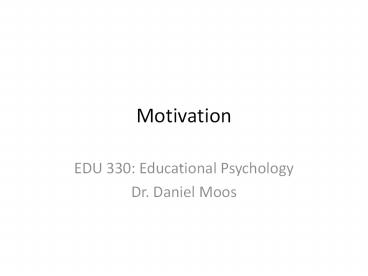Motivation - PowerPoint PPT Presentation
Title:
Motivation
Description:
Motivation EDU 330: Educational Psychology Dr. Daniel Moos Overview Video Objectives: Understand assumptions and applications of: Behavioral View of Motivation Social ... – PowerPoint PPT presentation
Number of Views:495
Avg rating:3.0/5.0
Title: Motivation
1
Motivation
- EDU 330 Educational Psychology
- Dr. Daniel Moos
2
(No Transcript)
3
(No Transcript)
4
(No Transcript)
5
Overview
- Video Objectives
- Understand assumptions and applications of
- Behavioral View of Motivation
- Social Cognitive View of Motivation
- Cognitive Views of Motivation
- Expectancy X Value Theory
- Humanistic View of Motivation
6
The Behavioral View of Motivation
- Students are motivated to complete a task by the
desire to obtain an externally provided
reinforcer (extrinsic reinforcement) - Limitations of the Behavioral View
- ? Temporary changes (in absence of reward)
- ? Materialistic View
- ? Undermining Effect with Intrinsic motivation
7
The Social Cognitive View of Motivation
- Two factors that influence motivation
- ? The models to which people are exposed
- ? The strength of ones self-efficacy for a
particular task - The Power of Persuasive Models
- ? Students who observe an admired model receive
reinforcement may be motivated to exhibit the
same behavior because they expect to receive the
same reinforcement (vicarious reinforcement)
8
The Social Cognitive View of Motivation
- The Importance of Self-Efficacy
- ? Choice of learning goals
- Task mastery goals
- Performance-approach goals
- Performance-avoidance goals
- ? Outcome expectations
- High self-efficacy ? high expectation of
positive outcome - ? Attributions
- Ability, effort, luck, task difficulty
9
Other Cognitive Views of Motivation
- Attributions Explanations that people tend to
make to explain success or failure
Controllable
Uncontrollable
Internal
Luck
Effort
Difficulty of Test
Choice of Study Environments
External
10
Attribution Theory Introduction (II)
- How do individuals typically attribute their
success and/or failure? - Interpret successes and failures in a manner that
is most likely to maintain positive self-image
Success
Failure
Success/Failure
Controllable
Uncontrollable
Internal
Luck
Effort
Difficulty of Test
Choice of Study Environments
External
11
Attribution Theory Introduction (III)
Attribution Locus Stability Controllability
Inherited ability internal stable
uncontrollable
Personality
internal
stable
uncontrollable
Effort
internal
unstable
controllable
uncontrollable
Task Difficulty
external
stable
Luck
external
unstable
uncontrollable
12
Other Cognitive Views of Motivation
Self-determination theory Process of deciding
how to act on ones environment (Ryan Deci,
2000)
Need Definition Classroom Application/Example
Competence
Feedback (Your problem-solving skills are
improving. Good work!)
Ability to function effectively in the environment
Independence and ability to alter the environment
Teacher asks for student input on rules,
encourages students to set monitor goals
Autonomy
Teacher spends time with her students before
after school, helping them w/ homework, etc
The feeling of being connected to others in ones
environment
Relatedness
13
Other Cognitive Views of Motivation
- Beliefs about the Nature of Cognitive Ability
- ? Entity Theorists
- Believe that intelligence is like a thing, or
entity, that has fixed characteristics - ? Incremental Theorists
- Believe that intelligence can be
gradually improved by adding to and
refining thinking skills - ? Developmental trajectory
14
Attribution Theory Case Study
15
Attribution Theory Strategies
- I am competent AND I worked hard
- NOT beneficial to completely attribute to ability
- (2) Students most likely to persist after failing
if they attribute failure to a lack of
appropriate effort - (3) Scaffold students understanding of effort
- Students often confuse spending time doing
ineffective activities with effort - Students often have incorrect conceptions of
their understanding (metacognition) - (4) Should assessment include evaluations of
effort?
16
Expectancy X Value Theory
17
Motivation Humanistic views (II)
18
Motivation Humanistic views (III)
- Applying humanistic views of motivation to the
classroom - Treat students as people first and learners
second. - Provide students with unconditional positive
regard by separating their behaviors from their
intrinsic worth. - Create safe and orderly classrooms where students
believe they can learn, and they are expected to
do so.































